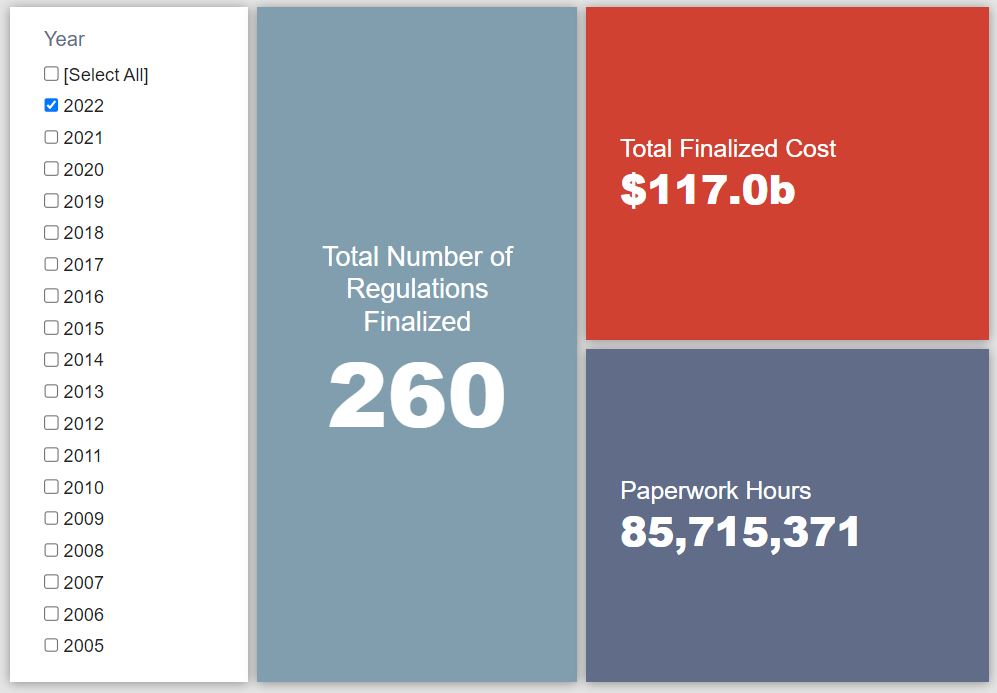Week in Regulation
December 27, 2022
Health Care Rule Continues Billion-dollar Trend
The week leading up to Christmas saw some notable action on the regulatory front. For one, the streak of total costs exceeding a billion dollars dating back to mid-November continued apace. Among the 13 actions with some quantified economic impact, however, there were only two that stood out – both, incidentally, from the Department of Health and Human Services (HHS). Across all rulemakings, agencies published $2.8 billion in total costs and added 534,891 annual paperwork burden hours.
REGULATORY TOPLINES
- Proposed Rules: 40
- Final Rules: 82
- 2022 Total Pages: 79,145
- 2022 Final Rule Costs: $117 billion
- 2022 Proposed Rule Costs: $156.8 billion
NOTABLE REGULATORY ACTIONS
The most consequential rulemaking of the week was the proposed rule from HHS regarding “Patient Protection and Affordable Care Act, HHS Notice of Benefit and Payment Parameters for 2024.” The proposal represents the latest iteration of a rulemaking HHS must produce each year. This edition makes a plethora of adjustments to how consumers interact with brokers and providers of “qualified health plans” on the insurance exchanges. All told, the various new reporting, recordkeeping, and disclosure requirements add up to roughly $711 million in annualized costs, or nearly $3.6 billion total over a five-year period.
The second-most notable rulemaking of the week was also a proposed rule from HHS, albeit one that went the opposite direction in terms of the cost calculus. This proposal, “Administrative Simplification: Adoption of Standards for Health Care Attachments Transactions and Electronic Signatures, and Modification to Referral Certification and Authorization Transaction Standard,” seeks to further establish a framework for the electronic transfer of health records in order to streamline such items as preauthorization and the adjudication of certain claims. According to HHS estimates – excluding its calculations for federal government health plans that count as transfer payments for our purposes – this proposed rule could yield nearly $850 million in total net savings across the health care system.
TRACKING THE ADMINISTRATIONS
As we have already seen from executive orders and memos, the Biden Administration will surely provide plenty of contrasts with the Trump Administration on the regulatory front. And while there is a general expectation that the current administration will seek to broadly restore Obama-esque regulatory actions, there will also be areas where it charts its own course. Since the AAF RegRodeo data extend back to 2005, it is possible to provide weekly updates on how the top-level trends of President Biden’s regulatory record track with those of his two most recent predecessors. The following table provides the cumulative totals of final rules containing some quantified economic impact from each administration through this point in their respective terms.
![]()
With most of the week’s action coming on the proposed rule side of things, the Biden Administration’s final rule figures moved only slightly: increases in costs and paperwork of $20.8 million and 45,020 hours, respectively. Likewise, the same period during the Obama Administration saw only marginal shifts. The Trump Administration, however, saw a notable increase in both figures that put a serious dent in the cost savings agencies had accrued through that point. A Department of Agriculture rule implementing the “National Bioengineered Food Disclosure Standard” brought roughly $5.6 billion in costs and 20.5 million hours of paperwork. Due to the surge in the latter, the Trump paperwork total moved back onto the net-increase side of the ledger.
THIS WEEK’S REGULATORY PICTURE
This week, the Department of Energy (DOE) proposes a new set of clean energy standards for federal buildings.

Specifically, the proposal seeks “to establish revised energy performance standards for the construction of new Federal buildings, including commercial buildings, multi-family high-rise residential buildings, and low-rise residential buildings.” While it is outside the purview of RegRodeo since “the only entities directly regulated by this rulemaking would be Federal agencies,” DOE has provided a cost-benefit analysis. That analysis includes some interesting findings.
The most significant finding is that the proposed rule could result in total net negative benefits – either $87.3 million under a 3 percent discount rate or $17.3 million under a 7 percent discount rate. This result is due to three key factors: 1) lifetime operating cost increases exceeding any “incremental product costs” savings, 2) net health disbenefits “driven by SO2 emission increases outweighing NOX emissions decreases,” and 3) limited climate benefits.
In a reversal of the typical effects of a new energy efficiency standard (i.e., increased up-front costs to provide savings down the road), this proposal would involve savings in upfront building costs but more expensive operating costs going forward. The core of this dynamic is summarized in this portion of the analysis’ discussion of annualized costs and benefits:
This unique arrangement, combined with the $15.9 million in health disbenefits against a mere $2.8 million in estimated climate benefits, yields (as DOE puts it) an “overall net monetized disbenefits” result. DOE does, however, include an alternative analysis that “assumes national power sector CO2 emissions reach 95% below 2005 levels by 2035 and are eliminated on a net basis by 2050.” Under this scenario, the rulemaking would yield $104.6 million in net benefits, due primarily to vast increases in the agency’s climate and health benefit calculations.
TOTAL BURDENS
Since January 1, the federal government has published $273.7 billion in total net costs (with $117 billion in new costs from finalized rules) and 190.7 million hours of net annual paperwork burden increases (with 85.7 million hours in increases from final rules).











